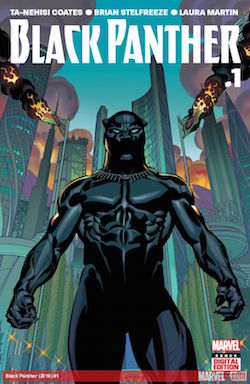Thursday Comics Hangover: Everybody's talking about the Black Panther

With all due respect to Stelfreeze, who is one of the best cover artists in superhero comics, those sales are due to the fact that everyone is anxious to see how Coates does with a new medium. Readers expecting a superheroic sequel to Between the World and Me — whatever that would even look like — will be disappointed. Coates has indicated repeatedly that he’s a lifelong fan of Marvel Comics, and that he’s interested in writing a superhero comic.
And so Black Panther is a superhero comic, through and through. It opens with a big fight, packed with laser blasts and super-powers and costumes. It’s dramatic, even operatic, and it’s a lot of fun to read. But even Coates at his nerdiest is still Coates, and his day-job interests are on display here: politics, race, violence, capital punishment. Even the plot seems of-the-moment for a United States whose political structures are hemorrhaging themselves to pieces: the Black Panther is a king of a high-tech African nation called Wakanda, but after years of turmoil his people seem ready for a new ruler.
Like some of the best superhero comics, Black Panther proudly waves the banners of its influences: Kanye West lyrics, tributes to other comics creators, elements of Afrofuturism. Coates is slathering the pop culture on thick, here, and it’s delicious. He's especially gifted at dialogue; the economy of word balloons and captions often escapes writers more used to the vast expanse of prose, but the words on the page in Black Panther strike just the right mix of portentousness, exposition, and brevity. Here’s the Black Panther’s internal monologue from early in the issue:
I came here to praise the heart of my country, the vibranium miners of the Great Mound. For I am their king and I love them as the father loves the child.
But among my children, all I found was hate.
The hate spread.
And so there is war.
You can practically hear the soundtrack ramping up behind those words (Brum-BAUMM!!!!) It reads like Stan Lee-style overblown dialogue, but with more natural poetry to it. The cadence has a majesty, a foreign rhythm, and the condescending tone — thinking of his citizens as children — indicates that perhaps the insurrection has a point to it. Those few words do a lot of work.
And so does Stelfreeze’s art. It’s been years since I’ve seen Stelfreeze do the interior of a book, and I missed his skill at storytelling. Take those first few pages where the Panther faces a crowd of angry Wakandans: every aspect of the melee is laid out plainly. Actions have consequences that we can see, and it’s possible to follow faces in the crowd throughout the fight. Later in the issue, Stelfreeze’s designs for Wakanda incorporate a whole host of visual vocabularies — African art, Egyptian design, weird Jack Kirby technology —to create a corner of the Marvel universe that we’ve never seen before.
In the end, Black Panther has to be one of the strongest first issues from a superhero comic publisher in a long time. It doesn’t feel too slight, or too weighty. It’s a ridiculously stylish package, with production values that put most of Marvel’s other output to shame. And it firmly situates a long-standing Marvel character into his own corner of the world, finally giving him a role and a purpose and a voice after years of disuse. This is what superhero comics should be doing all the time: crafting cultural moments around unique characters who resonate with the politics of the day.
-
It will be interesting to see what new comics readers make of Black Panther. They might not know that you should read the comic over a few times in order to fully appreciate it. The advertisements spread throughout the issue might prove to be too jarring for them. They might consider the years of backstory to be off-putting, rather than intriguing. In fact, a good portion of prospective Black Panther readers should probably wait for the trade paperback to come out this fall, because collected editions tend to be closer to the traditional reading experience than monthly episodic comics. ↩